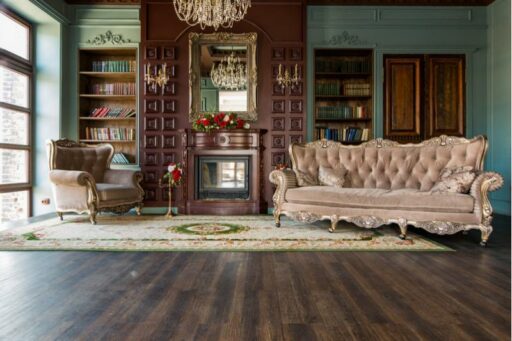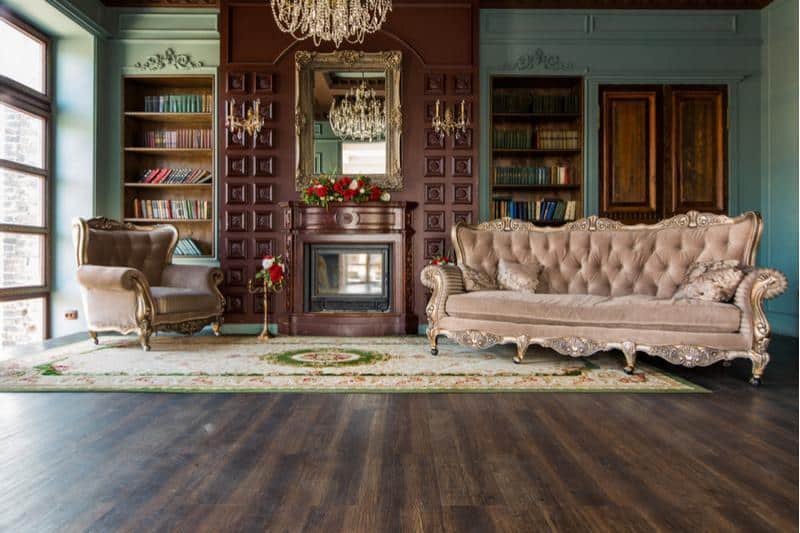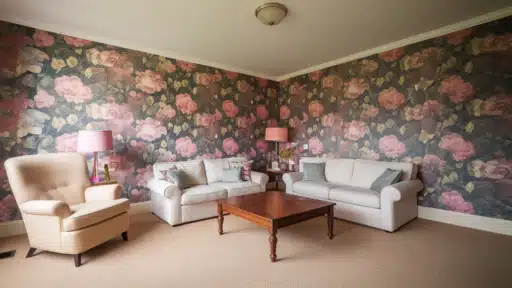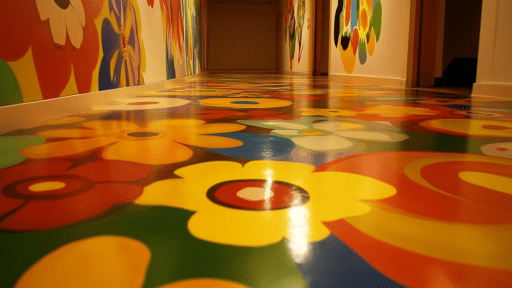Choosing between satin and gloss paint can be tricky.
Many homeowners are stuck in the paint aisle, unsure which finish will work best for their project.
It’s a common dilemma that can impact the look and durability of your painted surfaces.
Don’t worry – we’re here to help you make the right choice.
This guide will break down the key differences between satin and gloss paints, helping you decide which is best for your needs.
We’ll compare these two popular finishes across important factors like durability, ease of cleaning, and visual appeal.
By the end, you will have the knowledge to select the perfect paint finish for your home improvement project confidently.
Understanding Satin vs. Gloss Paint
When choosing paint for your home, understanding the differences between satin and gloss finishes is key.
These two paint types have unique qualities that affect how they look and perform in various settings.
Let’s take a closer look at each:
What is Satin Paint?

Satin paint offers a gentle sheen that falls between flat and glossy finishes.
Its soft glow adds a touch of warmth to any room without being too showy.
This type of paint works well in areas where you want a cozy feel, such as:
- Living rooms
- Bedrooms
- Family spaces
The subtle shine of satin paint helps create a welcoming atmosphere while still being easy to clean.
Pros of Satin Paint
- Creates a warm, inviting look in rooms
- Does a better job of hiding small flaws on surfaces
- Easier to fix up if it gets scratched or damaged
- Works well in many different types of rooms
Satin paint is a good all-around choice for its ability to look good while being practical.
Cons of Satin Paint
- Not as easy to clean as gloss, especially in busy areas of the home
- May show wear more quickly in high-traffic spots
- It doesn’t have the same eye-catching shine as the gloss
Satin paint might need more care in regions where it is used often.
What is Gloss Paint?

Gloss paint stands out with its high shine and light-reflecting qualities.
This finish is perfect for areas where you want to draw attention or create a striking look.
Common uses for gloss paint include:
- Trim and moldings
- Doors
- Cabinets
- Busy areas of the home
The shiny surface of gloss paint not only catches the eye but also holds up well to frequent cleaning, making it a good choice for spaces with a lot of activity.
Pros of Gloss Paint
- It gives rooms a bold, modern look
- Very tough and simple to keep clean
- Holds up well in areas with lots of activity
- It can make spaces feel brighter and bigger
Gloss paint is great for areas that need to be cleaned often or where you want to make a statement.
Cons of Gloss Paint
- It can make surface flaws more noticeable due to its shiny finish
- It is harder to touch up without it being obvious
- It might be too shiny for some people’s tastes
- It can be trickier to apply evenly
Gloss paint requires more careful preparation and application to look its best.
Key Differences Between Satin vs. Gloss Paint
When choosing between satin and gloss paint, it’s important to understand their key differences.
These variations can greatly impact the look and function of your painted surfaces.
Let’s explore the main factors that set these two finishes apart:
| Factors | Satin Paint | Gloss Paint |
|---|---|---|
| Sheen and Appearance | Low to medium sheen, smooth and subtle glow | High sheen, striking, and reflective |
| Durability and Resistance | Durable but less resistant to heavy wear | More durable, resistant to scuffs and scratches |
| Cleaning and Maintenance | Easy to clean, requires a gentler touch | Easier to clean, can handle intense scrubbing |
| Light Reflection | Reflects less light, creating a softer look | Reflects a lot of light, making rooms look brighter |
| Hiding Imperfections | Better at hiding minor imperfections | Highlights surface flaws due to high shine |
| Touch-up Capability | Easier to touch up without noticeable changes | Touch-ups can be tricky and may stand out |
| Drying Time | Dries faster | It takes longer to dry |
| Cost | More budget-friendly, especially for large areas | Typically, it costs more, especially for high-quality brands |
| Application Difficulty | Easier to apply, good for DIY projects | Harder to apply evenly, may show brush strokes |
| Longevity | Durable, but may not last as long as gloss | It tends to last longer due to the tough finish |
Where to Use Satin vs. Gloss Paint
Knowing where to use satin and gloss paint can make a big difference in your home’s look and feel.
Each finish has its ideal spots, depending on the room’s purpose and the effect you want to create.
Let’s explore the best applications for each type of paint.
| Area/Room | Recommended Finish | Reasoning |
|---|---|---|
| Bedrooms | Satin | Creates a cozy, relaxing atmosphere |
| Living Rooms | Satin | Adds a soft glow without being too showy |
| Hallways | Satin | Hides small flaws on walls while still being easy to clean |
| Family Rooms | Satin | Offers a comfortable feel for everyday living spaces |
| Kitchens | Gloss | Stands up well to cleaning and adds brightness |
| Bathrooms | Gloss | Resists moisture and is easy to wipe down |
| Doors and Trim | Gloss | Highlights these features and handles frequent touching |
| Modern or Sleek Designs | Gloss | Adds a polished look to contemporary spaces |
Making the Right Choice
When selecting between satin and gloss paint, there’s no one-size-fits-all answer.
Your decision should be based on the specific needs of your space and your personal style preferences.
Let’s look at key factors to consider:
Evaluate Your Needs Based on Space
Different areas of your home have different requirements.
Think about how each room is used:
- For high-traffic areas needing frequent cleaning and wear, gloss paint is often the better choice.
This includes places like kitchens, bathrooms, and areas around doorknobs. - Satin paint is usually preferred in spaces where you want to create a cozy and welcoming atmosphere.
This works well in living rooms, bedrooms, and family areas where a softer look is desired.
Consider Aesthetic Preferences
Your taste plays a big role in choosing between satin and gloss:
- If you’re going for a bold, eye-catching look, gloss paint can help achieve that; it’s great for adding a modern touch to your decor.
- Satin paint is an excellent option for a more classic and understated appearance; it provides a gentle sheen that enhances rooms without being too showy.
Remember, balancing practical needs with your design goals depends on the right choice.
Consider each room’s purpose and the overall style you want to create in your home.
By thinking through these factors, you can make a decision that you’ll be happy with for years to come.
Conclusion
Choosing between satin and gloss paint comes down to understanding your space and style preferences.
Satin offers a soft, subtle finish that’s great for living areas and bedrooms.
It hides minor flaws while still being easy to clean.
With its high shine, Gloss excels in kitchens, bathrooms, and on trim, providing durability and a bold look.
Remember, there’s no one-size-fits-all solution.
Consider each room’s purpose and the atmosphere you want to create.
Satin might be your go-to for a cozy, warm feel. Gloss could be the answer if you’re after a modern, easy-to-clean surface.
Ultimately, the best choice is the one that meets your specific needs.
Take time to evaluate each space, and don’t hesitate to mix finishes throughout your home for the perfect balance of style and function.
Frequently Asked Questions
What Is the Main Difference Between Satin and Gloss Paint?
Satin paint has a soft, subtle shine, while gloss paint is shiny and reflective. Satin gives a gentle glow, and gloss creates a bright, mirror-like look.
Which Paint Is Easier to Clean: Satin or Gloss?
Gloss paint is easier to clean. It can handle more scrubbing and stays looking good even with frequent cleaning. Satin is cleanable but needs a gentler touch.
Does Satin or Gloss Paint Hide Imperfections Better?
Satin paint hides imperfections better. Its lower shine doesn’t draw attention to bumps or flaws on walls, unlike gloss paint, which can make them more noticeable.
Which Paint Finish Lasts Longer: Satin or Gloss?
Gloss paint usually lasts longer. It’s tougher and better able to withstand wear and tear. Satin might need to be redone sooner, especially in busy areas.
Is Gloss Paint More Expensive than Satin Paint?
Yes, gloss paint is usually more expensive than satin. It costs more because it’s more durable and requires more work to make, but it might save money over time by lasting longer.








